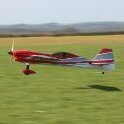-
Posts
92 -
Joined
-
Last visited
Recent Profile Visitors
793 profile views
Duncan Disorderly's Achievements
63
Reputation
-
Mmm lovely 70s PAs running Total Harmonic Distortion figures of whole percentages.... You can monitor unbelievably loudly with no ear-ringing afterwards on properly designed, ultra-low THD studio systems - it's just that they start at £££ 6 figures and go up - because it's the distortion that spanks your hearing (your ear doesn't appreciate you making it attempt a maxed-out square wave, though the anvil, hammer and stirrup have a brilliant way of completely uncoupling from each other to prevent the worst of the damage)
-
As far as I'm aware (lifelong pro sound engineer so tendency to know my onions here!) what you're experiencing there is due to pressure build up in the inner ear. Tinnitus is when a (or some) hair(s) inside the cochlea lay down and don't get up again. This triggers a permanent "on" for that frequency in the brain. I have several frequencies in an irritating mishmash that has no harmony at all - a result of my youth thrashing drums with no hearing protection. Snare drum and cymbals are the worst culprits. I worked with an engineer who used to put painful amounts of upper mids into everything he did - turns out he went shooting as a kid and had wiped out a huge curve of frequencies which he was compensating for, which would be fine if everyone else had wiped out the same curve. Engineer joke: (insert name of known loud musician)'s tinnitus is so loud everyone can hear it. I'll get my coat.
-
Sorting through old videos, I liked the sounds on this one. The pilots asked for their own slot so we put the camera on a traffic cone in the middle of the strip and asked them to get as close to it as they could. Given the 110 degree lens, they're a lot closer than it appears. I've edited out the other 3 sides of each circuit so it's just the good stuff left in. Even the leccy Mustang sounds ok! REC_1145 corsair & mustang - Trim01 (online-video-cutter.com)1.mp4 Don't forget to turn your volume down again afterwards 😀
-
What I typed was "total watts" and the robots did the rest! (They were probably continuing an earlier conversation about capacities, saw me type "watts" and thought "we know what to do here"... Apologies, I'm normally good at checking my posts for errors) So e.g. put a 3kW/4hp limit and it's up to you how to multiply the amps and volts. A voltage limit doesn't control anything (other than volts, obviously)!
- 66 replies
-
- electric flight
- battery charging
-
(and 1 more)
Tagged with:
-
Brilliant - I'll leave that one up to you! That sounds very sensible Well, yes... internationally... but nobody would mind domestically if you based it on total wattHours instead, as you wouldn't be getting any advantage. And nobody would check anyway! That's interesting cos I'm forever extending battery trays towards the back of the plane or adding tail weight - no matter which airframe - so lighter packs would suit me fine! Indeed - these are good times to be flying electric I'll come and get that Elixir any day now!
- 66 replies
-
- electric flight
- battery charging
-
(and 1 more)
Tagged with:
-

Finally made a charging station....
Duncan Disorderly replied to Graff's topic in Gadgets and Electronics
Phil got there before me! 6S8P to run a pair of chargers at 24V to fast-charge LiPos at the patch - thread here - I thought it was what you were doing until I realised there was no battery pack... I assembled the packs so they can be whatever voltage/capacity/price you need them to be. It may look expensive but you don't need to buy anywhere near as many LiPos, so they break even really quickly and last for years. Lots of other advantages too. Mythbusting about charging at high C rates here (and all LiPo charging is happening outdoors anyway) - but always check your batteries can take over 1C rates to prevent unwanted explosions, and if they can't then buy ones that can when they're up for renewal (they'll be much better batteries all round) But having said all that, it may not be long now before we're all flying Li-ions rather than LiPos, though we'll still need these larger packs to recharge them at the field. -

Finally made a charging station....
Duncan Disorderly replied to Graff's topic in Gadgets and Electronics
Stick one of these in it and take it to the field with you! -
Perfect for the job! Have fun at OW. The latest test packs of the newest Li-ions (6S2P 8000mAh but unsure of manufacturer) were sustaining over 100A at WOT, so it won't be long before we're using them in the planes instead of LiPos. We've got Roger's Junior 60 on a Li-ion pack at the Coventry club, giving almost an hour in the air, so now it's just a matter of amp draw for our aerobats. While I'm here updating this thread: Russ's original box finally got too unbalanced at almost the 5 year mark, so he unsoldered it all, tested each cell, threw out the rubbish ones and resoldered the good ones - so it's still going after the rebuild with cells that he got second hand (for free IIRC) in the first place. So a couple of pence per flight (not that we're doing it this way because it's cheaper - but it is a lot cheaper!) My pair of 6S 3300 LiPos' balance leads have all broken (only a couple remaining on each) and I can't be bothered to take them apart to the required extent to fix them. They're on 736 cycles each now and I'm just doing unbalanced charging at the field and seeing how long they can handle that for. I think that I might have made my point about charging at high C rates by now - they've worn out mechanically not chemically!
- 66 replies
-
- electric flight
- battery charging
-
(and 1 more)
Tagged with:
-
That's looking lovely Adrian! The spinner template is a stroke of genius. A couple of pics of a baby Skywing NG that still has these nice features: It's the stuff that costs 2p that makes a difference - these servo cable plugs that stop the cable end disappearing into the wing every time it's removed The diddy version of the wing retainer ...it's the same "can't put on the canopy with the wings unlocked" system The pre-installed tail end cable runs make the Rx install nice 'n' tidy Binding at about 1am this morning so I could get the servo arms on (but fell asleep instead) Servo arms have just been installed this frosty morning, so I'm off to fly it
-
Optical illusion - it's not me flying straight and level with a Space Shuttle launching in the background, it's me flying knife edge directly overhead across a contrail - a deliberately posed shot Shot into the light but I like the smoke trail and the sheep Blue Angels landing My avatar pic. Hopeless really but I've always liked the movement in it. I'd been taking heli pics, trying to get the blades as a whole disc (and failing miserably), so when my clubmate grabbed my camera to take this pic of me taking off, the camera still had the slow shutter setting At a Banbury fly-in day Not a formation you see often! Autogyro slot @Steve Jones 2 not sure if you ever saw these?
-
Full Cub sequence - DUCK! This is at about half speed as GIFs get a bit hectic any faster. I remember thinking, when he swooped down low, that at least I'd be able to show them what happened at A&E...
-
Stu flying! No, really! Clive's Cub low from the right. Eventually I went out and laid as flat to the ground as I could and he flew it right over my head, capturing this beauty (which was published in the back of RCM&E) ...and yes, it was potentially as dangerous as it looks... but what a pic!
-
A few pics from the old Sulgrave site of the Banbury club - now an unsightly blot on the landscape courtesy of HS2 (a 300m wide cutting for a tunnel exit) Mark Holman always turned out an immaculate plane A very detailed foamy P-51 Returning from tugging a glider - towrope just visible Kept disappearing into the sky - too thin for its own (photographic) good and even when I could see it it was too fast! Another foamy returning from a sortie Sweet dual landing (Minion piloting the Decathlon) Doesn't work with the prop in any other position! Stu getting in some pyro practise for Weston Park - missed the plane though Taken by a clubmate of me landing my Sebart Pitts Literally thousands more but they're unsorted and on another PC. I'll get around to it... In the meantime, here's a red kite showing us all how to do it
-
Here you go Adrian - it looks like this at the moment. I've got a GA3000.7 waiting to go into it, running 8S 4000 batts. It's the V2 so doesn't have the removable elevator the V3 has. Mark, who I bought it from, has crafted a set of tabs for them so they screw in and are thus removable, though I tend to leave them attached up to 74" size. He's bought the V3 and I was happy to scoop this one up from him (we've done this dance many times before!) Also picked up a Skywing 60" NG that's awaiting fitting out, but it's the same high construction standards even on their little stuff - including the funky wing mechanism. Got that one off Clive (and we've done the dance so many times now that I'm considering setting up a Direct Debit) From what I've seen so far I'd say Skywing are better than Pilot and almost up there with Extreme Flight which, to be fair, is accurately reflected in their price points. Talking of EF, they're getting with the program on fasteners themselves: here's a nice touch on their 60" Gamebird, about halfway down the side of the canopy, a carbon tab in the fuselage that mates with a slot on the canopy frame, one on each side It's in addition to the usual canopy latch on top. It's definitely not coming off in flight. Or, if it does, it can be considered an achievement! Because I don't know how to create the forces that would make them come undone. Also, on their 85" Gamebird, everything is fastened with sprung catches like this ...in fact the only things that bolt on are the SFGs. << Excuse the thread drift to EF but it was still about innovative fasteners! >>
-
Good pics, thanks Adrian. Their 73" Laser 260 came my way today and I have to say those wing/ele retainers are excellent and I really like the magnetic bolts too. Simple, functional design. Haven't flown one of theirs yet but I have it on good authority that I won't be disappointed. ...yeah but think how much time you'll save not having to undo the linkages every time you take them off!





